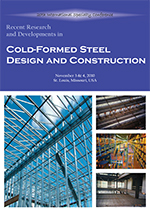Session Dates
03 Nov 2010
Keywords and Phrases
cold-formed steel||LSF floors||gypsum plaster board||fire test||insulation||fire rating||finite element analysis
Abstract
Light gauge steel frame (LSF) struct ures are increasingly used in commercial and residential build ings because of their non- combustibility, dimensional stability and ease of installation. A common application is in floor-ceiling systems. The LSF floor-ceiling systems must be designed to serv e as fire compartment boundaries and provide adequate fire resistance. Fire-rated floor-ceiling assemblies have been increasingly used in buildings. However, limited research has been undertaken in the past and hence a thorough understanding of their fire resistance behaviour is not available. Recently a new composite floor-ceilin g system has been developed to provide higher fire rating. But its increased fire rating could not be determined using the currently available design methods. Therefore a research project was conducted to i nvestigate its structural and fire resistance behaviour under standard fire conditions. This paper presents the results of full scale experimental investigations into the structural and fire behaviour of the new LSF floor system protected by the composite ceiling unit. Both the conventional and the new floor systems were tested under structural and fire loads. It demonstrates the improvements provided by the new composite panel system in comparison to conventional floor systems. Numerical studies were also undertaken using the finite element program ABAQUS. Measured temperature profiles of floors were used in the numerical analyses and their results were compared with fire test results. Tests and numerical studies provided a good understanding of the fire behaviour of the LSF floor-ceiling systems and confirmed the superior performance of the new composite system.
Department(s)
Civil, Architectural and Environmental Engineering
Research Center/Lab(s)
Wei-Wen Yu Center for Cold-Formed Steel Structures
Meeting Name
20th International Specialty Conference on Cold-Formed Steel Structures
Publisher
Missouri University of Science and Technology
Document Version
Final Version
Rights
© 2010 Missouri University of Science and Technology, All rights reserved.
Document Type
Article - Conference proceedings
File Type
text
Language
English
Recommended Citation
Baleshan, B. and Mahendran, M., "Improvements to the Fire Performance of Light Gauge Steel Floor Systems" (2010). CCFSS Proceedings of International Specialty Conference on Cold-Formed Steel Structures (1971 - 2018). 2.
https://scholarsmine.mst.edu/isccss/20iccfss/20iccfss-session4/2
Improvements to the Fire Performance of Light Gauge Steel Floor Systems
Light gauge steel frame (LSF) struct ures are increasingly used in commercial and residential build ings because of their non- combustibility, dimensional stability and ease of installation. A common application is in floor-ceiling systems. The LSF floor-ceiling systems must be designed to serv e as fire compartment boundaries and provide adequate fire resistance. Fire-rated floor-ceiling assemblies have been increasingly used in buildings. However, limited research has been undertaken in the past and hence a thorough understanding of their fire resistance behaviour is not available. Recently a new composite floor-ceilin g system has been developed to provide higher fire rating. But its increased fire rating could not be determined using the currently available design methods. Therefore a research project was conducted to i nvestigate its structural and fire resistance behaviour under standard fire conditions. This paper presents the results of full scale experimental investigations into the structural and fire behaviour of the new LSF floor system protected by the composite ceiling unit. Both the conventional and the new floor systems were tested under structural and fire loads. It demonstrates the improvements provided by the new composite panel system in comparison to conventional floor systems. Numerical studies were also undertaken using the finite element program ABAQUS. Measured temperature profiles of floors were used in the numerical analyses and their results were compared with fire test results. Tests and numerical studies provided a good understanding of the fire behaviour of the LSF floor-ceiling systems and confirmed the superior performance of the new composite system.



